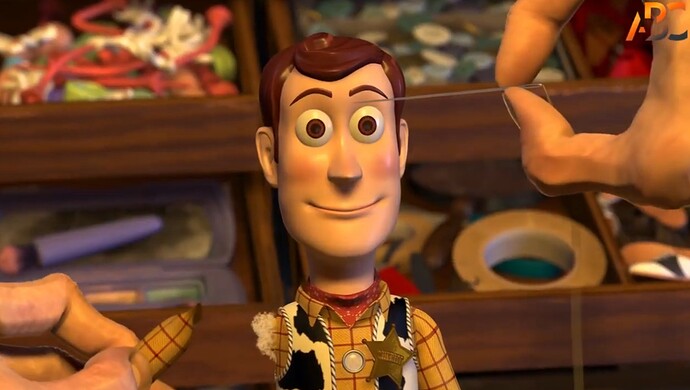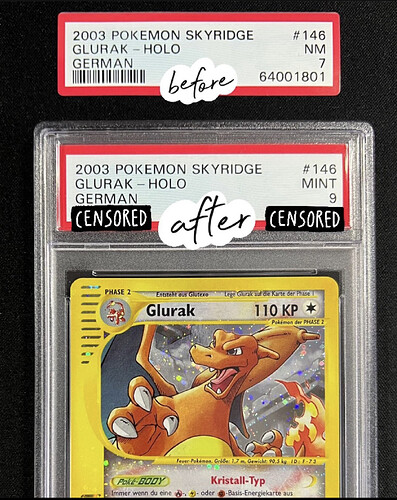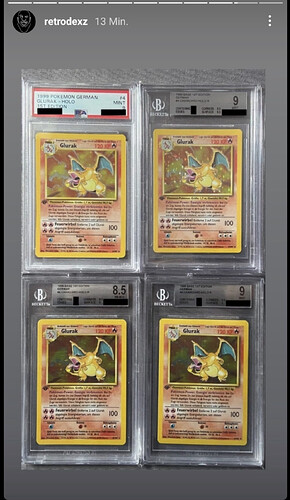Mine will be sealed underground with me like King Tut.
One class of cards that could be especially affected: Evolutions regular holos.
They almost always get PSA 9, and I assume in the well-centered cases it is almost always because of print lines.
Some of those cards have ludicrously low PSA 10 populations.
If the alteration can remove those print lines then there will be massive financial incentive for people to do so.
Maybe I need to rethink my Evolutions PSA 10 master set goal. A goal that is so heavily based on modern card condition rarity feels somewhat cheapened and vulnerable now.
I guess we’ll see just how widespread this becomes.
Patreon for sure is the most concentrated pool of serious collectors, but my public videos can get anyone. Especially anything that potentially relates to modern english. Those always have the biggest brain comments! ![]()
I definitely think if you could remove scratches, a lot of wotc PSA 9 holos would benefit. Think T17 or Genesis Lugia. I have a lot of holos that are 10 candidates being held back by a few holo scratches.
The other thing I wanted to mention is that I think it would be hard to genuinely clean the holo without detection. In the printing process, a layer of spray is added on right after the ink is applied to the sheet. This gives it the slightly matte-glossy effect you’d see on a pack-fresh wotc card. Relevant article:
I have a hard time seeing how you could fix the holo without damaging this layer in the process.
and rediscovered in 2000 years… the last remnant and only guide for hyper-advanced humans to know about our 21st Century life.
I haven’t seen, and maybe I missed it, discussion about chemically cleaning cards, vs restoring artwork (which does include chemicals to some degree. Is this not a comparison that can be made because these are mass-produced items, and not individual artwork? hmm…
interesting. I’d wonder though, are the scratches not in this protective layer?
In my experience acetoning just a few cards, I noticed that some eras (BnW for example) have a more sturdy top layer. Also, once the acetone has done it’s job, It seems to have fewer scratches, so I assumed that the fixitive layer was what was scratched (but it could be the ink), like the top layer of plastic that we’re polishing with the PlastX.
Additionally, I’ve tried making 3D cards for fun, and when I apply a resin I need to spray the cards with art fixitive to prevent the ink from bleeding into the resin as it cures. Just interesting related info.
The most concerning thing to me is not what the cards look like now, but what they will look like in 10 years. If I bought what I thought was a mint card and it ended up melting in three years I would lose my mind… ![]()
Trying to be pragmatic. If it cannot be changed, learn to exploit it instead.
I don’t get it,
Clean a card with water it’s fine.
Clean a card with water/detergent (you know dishwashingn stuff) it’s oke
Clean a card with acetone or whatever chemical stuff it’s suddenly altering.
It’s the same way that that washing your car is not damaging it but gouging the side and and peeling off the paint with a scraper is.
PS don’t use acetone to clean your card
Water isn’t going to remove holo scratches.
Also do you think inking a card is cleaning it?
We need someone with a 3D microscope to help educate people on what’s happening. If people saw the changes under a microscope I don’t think anyone would question it, since it would be clear that layers of the card are actually being removed or filled in.
This should clear up the science. Everything is altering.
Natural decay due to entropy and physical processes is different from artificial attempts to reverse said effects. Especially when those attempts leave evidence behind.
I have no idea if they are adding or removing but just the act of touching your card ie a soft cloth and a bit of water you are removing part of the card aswell. Its all a case of how much is acceptable.
Im a purist just so everybody knows. Leave things as they are.
I have kids, so I have the pleasure of watching toy story on repeat. In Toy Story 2, woody is stolen to be sold off to a collector. This whole card “cleaning” debate makes me think of the scene where, before being sold, Woody is taken to a “cleaner” to get his arm cleaned. Oddly enough, when I googled the scene, it came up as “the cleaner”. Anyways, here’s a picture of Woody’s arm being “Cleaned”.
There’s also a 2 minute clip of the whole scene on YouTube.
What about, using a cleaner on your car? The side effect is you see more shine but still I don’t think you remove a layer.
the side effect of this is you see less scratches.
Don’t be afraid, I only use acetone to remove my nailpolish…
It’s more I like to give a different perspective how to look at it.
To be honest I saw somebody posting, water and microfiber cloth to remove finger oil.
Microfiber will leave scratches, that’s how it’s “cleans”. But that 's another issue.
Using ink to hide white spots? I don’t like it, I am only trying to look at it from a different perspective.
But I can see the point. Both ink and this “cleaner” are not used to remove something but adding something on the surface. And as a side effect the “cleaner” removes scratches.
Seems like the „card restoring“ services in Germany become more popular… here are some screenshots from a provider that show his before and after results…
It’s personally a no-go for me but I see more and more comments who are actively seeking for persons who can do this, which worries me a lot



